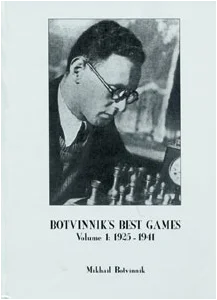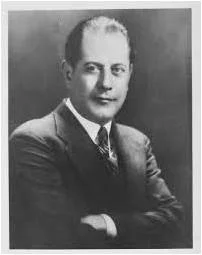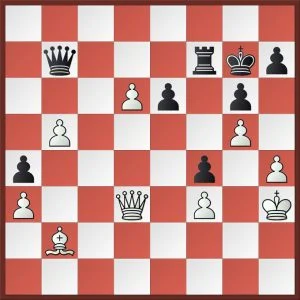Botvinnik’s Best Games Vol.1: Review
Two years ago the chess world celebrated the 100th Birth Anniversary of Mikhail Botvinnik, the sixth world champion. Way back in 1980s the Patriarch, as he was known, authored a famous trilogy, Аналитические критические работы.
This has been translated by Dr. Ken Neat and published as Botvinnik’s Best Games by Moravian Chess Publishing. The series deserves to be better-known. Here is a review of the first volume-Ed.

Botvinnik’s Best Games Volume 1: 1925-1941 by Mikhail Botvinnik Translated by Dr. Ken NeatHardcover, 392 pages Moravian Chess. 2000

Leningrad 1925. The First Category Tournament is in progress. A shy bespectacled lad is waiting for his game to begin. His name is Misha and he is only 14-years-old. Other players do not think much of him. How can they? He has already lost two games and is in the lower half of the score table. But today he is determined to win.
Perfiliev – Botvinnik 1925

Black to move
Download game in pgn
Misha finished third in this event. But his confidence had grown, and thus began the remarkable career of a great player whom we now recognize as Mikhail Moiseevich Botvinnik (1911-1995), 6th World Champion.
The first volume of his Best Games here deals with the early phase of his eventful life when he rose to become the USSR Champion and also participated in international tournaments like Moscow 1935, Nottingham 1936 and AVRO 1938. It was in these events that he played with his predecessors, Lasker, Capablanca and Alekhine and peers like Euwe, Reshevsky and Fine.

Jose Raul Capablanca
Capa was Botvinnik’s idol, but the Cuban’s powers were put to severe tests by his young admirer and rival during the 1930s. Botvinnik finished ahead of Capa in Moscow 1935. But in Moscow 1936 they raced neck and neck until they met in the 7th round.
A terrific battle that also determined the outcome of this tournament. Capa remained unbeaten and finished first. Botvinnik was second, trailing behind by just one point. And it was just this game that cost him the first prize!

Botvinnik-Capablanca Moscow 1936

White to move
Download game in pgn
Two years later the rivals were to meet again in AVRO 1938 and the younger man was to beat his idol in an historic game that he called the game of his life.
Much of Botvinnik’s analysis has stood the test of time. But some of it has been subjected to revision, especially by his disciple, Garry Kasparov (notably in My Great Predecessors Part II). As for the present trilogy, the translator Dr. Ken Neat has taken pains to correct the lines given in the original Russian edition. In some cases theory itself has moved on after decades of trial and error. A case in point is the 8….Qd8 line that we saw in the game Perfiliev-Botvinnik, 1925.
Here Black missed the bus with 12…Nxd4?
Two Knights Defence 4.d4 Variation

White to move
Download game in pgn
All the same it’s remarkable that young Misha scored a win from a lost position. And he was just 14-years-old!
Similarly in the Botvinnik-Capablanca battle Black probably missed a draw in the following position:

Black to move
38…Kg8! 39.Qc3 e5 40.Qc6 Qd7+ 41.Kg2 (41.Qxd7 Rxd7 42.Bxe5 Kf7 43.Bxf4 Ke6 44.b6 Kd5 45.Kg4 Kc6 46.Be5 Kxb6 47.f4 Rf7 48.f5 gxf5+ 49.Kf4 Kc6 50.h5 Kd5=) 41…Qe6 42.b6 Qb3 43.d7 Qxb2+ 44.Kh3 Qe2 45.d8Q+ Kg7!= It’s remarkable that White cannot prevent perpetual check in spite of having two queens.
In their analysis neither Botvinnik nor Capablanca considered 38…Kg8. It appears that the Black king would be in great danger after 39.Qd4+. If he tries to save the king, White advances his passed pawns and promotes one of them with a queen. However, 38…Kg8! does draw as shown in the above analysis.
This brings me to the openings in this volume. Botvinnik excelled in Closed and Semi-Closed games. If you are an aficionado of the French and the Dutch, the Queen’s Gambit and the Slav, you cannot miss this work at all.
There are many memorable games here. Don’t miss those games with Lasker, Capabanca and Alekhine, not to mention Levenfish and Panov and among others.
How does this volume compare with the earlier 100 Selected Games? First, Botvinnik has taken the trouble of correcting his own analysis wherever possible. Second, this book has 124 games covering the period 1925-1941. The earlier book has 78 games for the same period and it concludes with the year 1947, the year before he became world champion.
It would be churlish to point out flaws in a major undertaking of this kind. Only a reviewer’s duty demands that one should. The printing standards are just OK. On occasion a few words are misspelt. The images are a mixed bag. Some are rare and many familiar to students of chess history. A few do not belong to this volume as they feature later figures like Tal and Petrosian. In a couple of cases rivals like Boleslavsky and Rauzer are not identified. But these are minor blemishes in a work of this kind.
In the next review I shall deal with the second volume of this magnum opus.
Get the BOOK: Botvinnik’s Best Games Volume 1: 1925-1941
Courtesy:
The images of young Botvinnik and Capablanca are from ChessPro.Ru
All these images are also found in the public domain.
Notes:
1)This review first appeared in the now defunct Chessville.com. Old fans of the site can still have a look:
2)I checked my discovery of 38…Kg8! with Mr. Charles Sullivan, an outstanding analyst and he concurs. By the way his site is worth a visit.
3) For reasons of length I have not offered Botvinnik’s own analysis of these games in the review. Some day they might find their way here.










Comments: